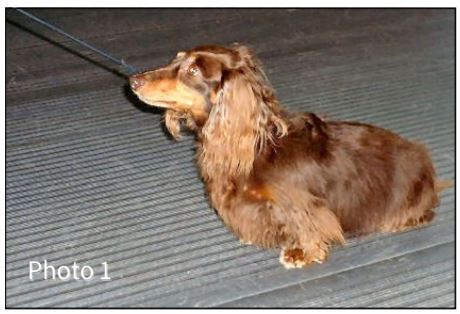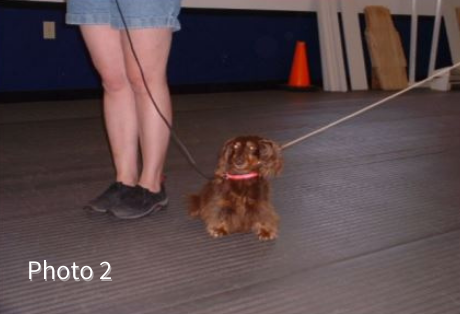Opposition Heeling - Help for the Lazy Heeler!
Jun 16, 2021Updated 1/12/22 - At the time this video was recorded, I was not utilizing a Reward Marker. I've made several edits to the article below (written in red text) to include exactly when you should use your Reward Marker. Doing so will ensure your dog knows the exact behavior you are looking for - to work hard to stay in perfect heel position!
Even if your dog is paying attention while trotting along next to you, you may be fighting his tendency to drift wide or lag. If this describes your situation, try using “opposition reflex” to improve your performance.
Opposition reflex is the term used to describe a dog’s natural tendency to oppose a force. For example, if you try to push a dog into a down position by applying pressure straight down on his shoulders, he will lock up his elbows and oppose the pressure. You can often use a dog’s opposition reflex to your advantage. When you stack a conformation dog and then pull back on his tail, he will lean forward or appear to be pushing his chest out. When you put a dog in a sit-stay and pull gently but steadily on the leash, the dog can learn to resist the pressure on the leash and work harder at maintaining his sit (Photo 1).


The following drill has long been helpful with small dogs that stop during a heeling pattern or heel wide in an attempt to avoid being stepped on. However, many large dogs that heel wide or lag can benefit from the drill as well.
Begin with your dog in a sit in heel position. Attach a long line to a second collar on the dog and have a helper stand off to your left side. While your dog is sitting in heel position, your helper will pull gently but steadily on the long line, attempting to pull your dog out of heel position (Photo 2). If your dog gets up and moves toward the pressure, let him move 2-2.5 feet before your helper stops pulling, and you then give a pop on the leash and tell him “heel” in a surprised and dismayed tone of voice (Photo 3). As soon as your dog gets back to sitting in heel position, use your Reward Marker to mark the correct position, and reward him.


A pop on the leash is legitimate since it signals to the dog that he has failed to pay attention, and indeed he has allowed someone to pull him away from his job of sitting next to you, in heel position! Your tone of voice needs to be such that he recognizes that you are surprised, amazed, and dismayed that he would be so easily distracted.
It won’t take too many repetitions before your dog will resist the pressure on the long line and fight to stay in a sit next to you (Photo 4). He may even lean into you as if to say, “Hey, this guy over here is trying to get me in trouble, but I’m not going!” You can mark and pay this excellent effort!
Now heel forward at a slow pace and have your helper walk along next to you. Your helper should gently pull the rope. If your dog allows himself to be pulled out of position, let him get 2-2.5 feet away from you before your helper stops pulling and you say, “Heel” as you pop the leash (Photo 5). As soon as your dog gets back to heel position, use your Reward Marker to mark the correct position, and reward him.

As in a sit, it won’t take too many repetitions before the dog will resist the pressure from the rope and be pulling to stay in heel position (Photo 6). It is not necessary to have your helper pull constantly on the rope. Simply have the helper pull and release and then pull and release again. Your dog may begin to crowd and forge, that is a natural backlash to the lesson, so try not to overdo it. If your dog is making a good effort to stay in heel position, resisting being pulled out of position, be sure to use your Reward Marker to mark this effort!

The final step is to heel at a normal pace. Once you speed up to a normal pace, instruct your helper to try to pull your dog out of position when he makes a heeling error. For example, if your helper sees your dog start to lag, he can pull back on the rope slightly in an attempt to make the error worse. It is likely that your dog will immediately speed up when he feels the tension on the rope. However, if he does not, your response continues to be a “Heel” command accompanied by an attention correction. As soon as your dog gets back into correct heel position, use your Reward Marker and reward him.
Most of the handlers that try this drill feel as if their dogs quickly begin to try much harder during the heeling exercise. The dog’s attention increases, and the effort he makes to maintain position increases. If this is your experience, the drill has been effective for you.
My first experience using this drill happened to be with a Bassett Hound that the handler had trouble motivating to remain in heel position. After the dog had been taught to oppose pressure on the rope while heeling, we used it every 4-5 days, as we saw the dog start to become a bit disinterested in the heeling exercise. The “helper” would simply follow along next to the dog, in the same way that a judge often does, and apply pressure to the rope whenever the dog made a heeling error. The handler would respond with an additional heel command and a pop on the leash. It proved especially effective on about turns and right turns.
As the dog improved, we were soon able to use the drill during off leash heeling. Even though the owner did not have a leash on, if the dog began to make an error, the helper would make the error worse by pulling on the rope and the owner would say “Heel!” By that time, the dog expected a leash correction when he heard “heel” in that tone of voice, and would hustle back to the proper position.
The final step was to take both the leash and the long line off the dog. Whenever the dog started to make a heeling error, the “helper” would speak to the dog in a distracting way, “here boy, come on over here!” The dog would recognize that he was being set up and hustle back to heel position. Be sure to regularly mark and pay your dog's decision to remain focused and stay in heel position.
With this particular dog, we went so far as to warm him up outside the ring with two leashes and a helper. This seemed to be the only way to help him remember just how hard he had to work to maintain heel position in the ring. On a few occasions, when he did get grossly out of position, the handler double commanded with a verbal “Heel” command and he snapped right back into heel position to finish the exercise. The owner had sacrificed 3 points for giving an additional command, but not 40 for failing the exercise.
Obedience Road is NOW OPEN!
Access the tools & support you need to become the obedience team of your dreams.

